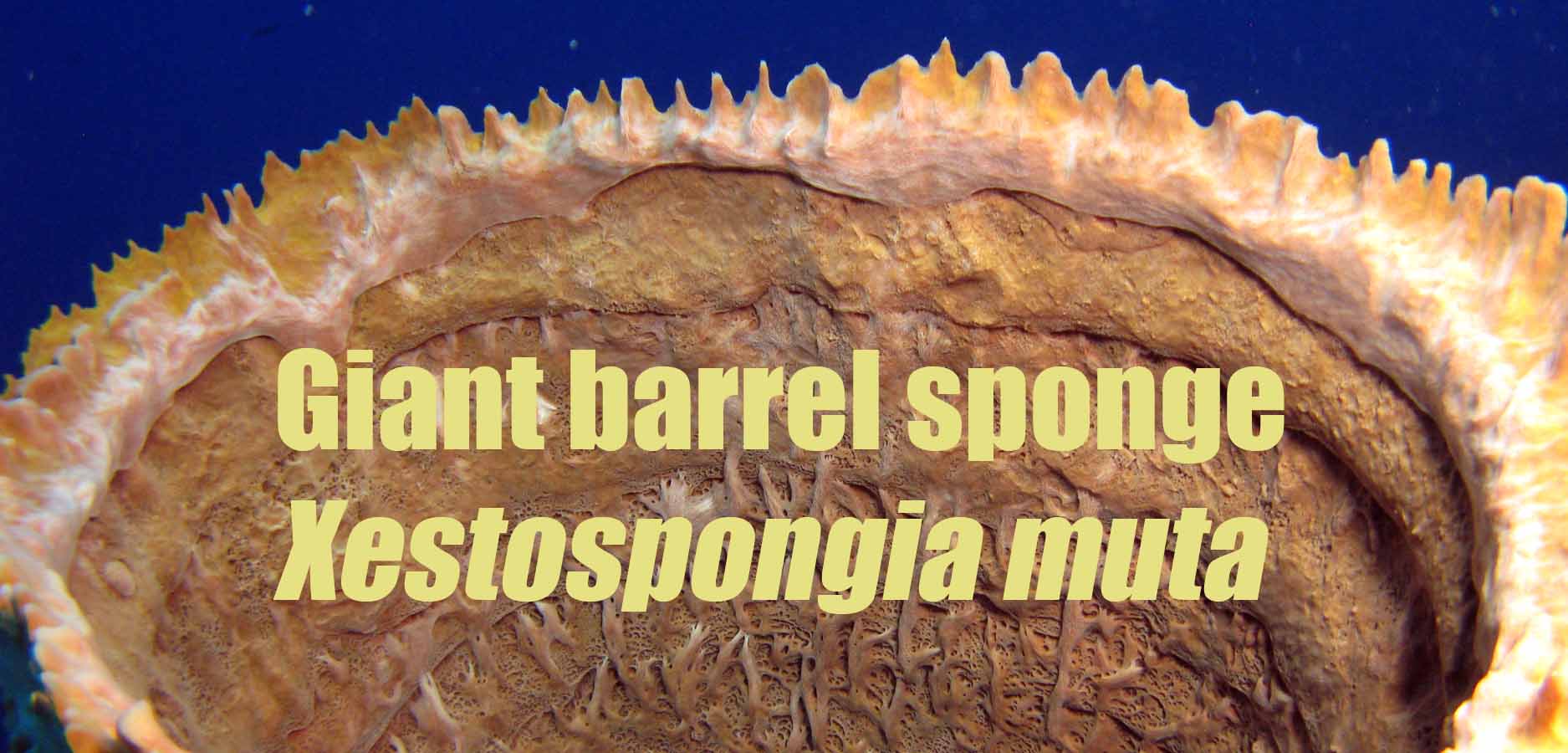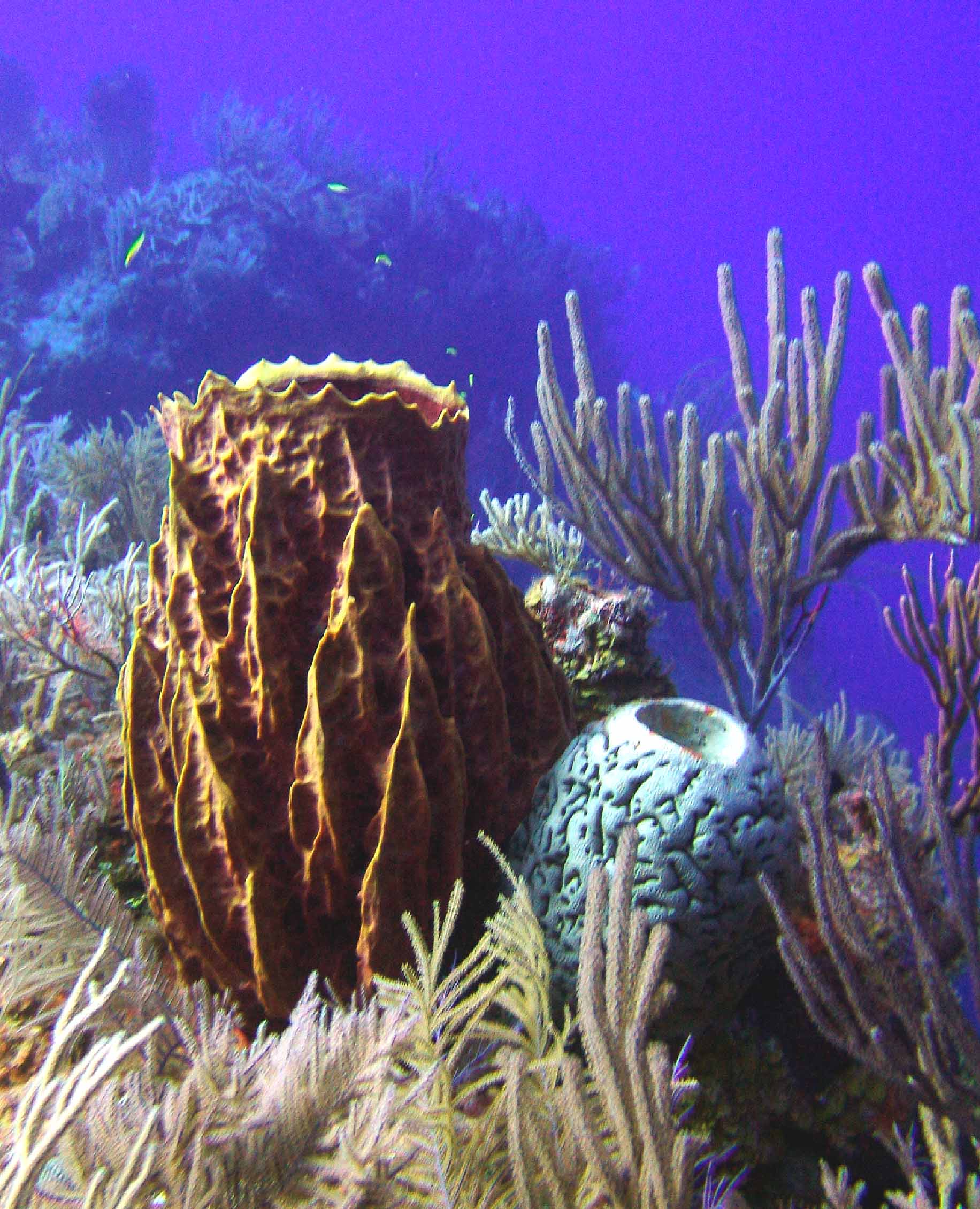People:
Joseph Pawlik
Graduate students
Information for undergrads and
prospective grad students
Science:
Marine chemical ecology
Giant barrel sponge Xestospongia muta
Marine invertebrate larval
biology
Photographic guide to sponges of the Caribbean
Courses:
BIO 318:
Invertebrate
Zoology
BIO 501: Science as a Profession
| HOME |

WATCH A VIDEO OF RESEARCHERS DIVING WITH GIANT BARREL SPONGES IN THE BAHAMAS: http://youtu.be/8WaWVuGE-LM

|
The Caribbean
barrel sponge, Xestospongia muta, is a large and common member of the
coral reef communities at depths greater than 10 m, and has been
called the “redwood of the deep”. Despite its prominence, high biomass and importance to habitat complexity and reef health, very little is know about the basic biology of this massive sponge, including rates of mortality and recruitment, reproduction, growth and age. Like reef corals, this sponge is subject to bleaching and subsequent mortality. |
| With support from NOAA's Aquarius Reef Base at UNCW, NOAA's Coral Reef Conservation Program, and the Florida Keys National Marine Sanctuary, our research group has been monitoring populations of X. muta in the Florida Keys since 1997. Surveys are conducted twice a year, creating one of the largest datasets on sponge population dynamics, as well as observations on rates of bleaching, incidences of disease, and effects of marine debris on sponges. Click on the links below for more specifics: |
 |
With a library of over 5000 digital images of 600+ sponges from 12 permanent, 16 m diameter circular plots on Conch and Pickles reefs off Key Largo, we modeled growth to estimate ages of large sponges within our plots at >100 years, and very large X. muta at other sites at over 2000 years old, placing these sponges among the oldest animals on earth (McMurray et al. 2008). We described cyclic and fatal bleaching of this species (Cowart et al. 2006), but determined that the more common cyclic bleaching has no detrimental effect on sponges (López-Legentil et al. 2008). As part of a reciprocal transplant experiment designed to test the causes of sponge bleaching, we developed a novel technique for reattaching X. muta to the substratum after dislodgement by storms or marine debris (McMurray & Pawlik 2009). We determined the genetic structure of populations of X. muta from Florida, the Bahamas and Belize using the I3-M11 partition of COI (López-Legentil & Pawlik 2009), which showed a strong correlation with patterns of ocean currents. Finally, we applied stage-based matrix modeling to our long-term monitoring data to study the demographics of X. muta, and determined that populations of this important species are increasing on Florida’s reefs (McMurray et al. 2010). Our ongoing monitoring will continue to be valuable because non-calcifying reef organisms like sponges will likely benefit from negative impacts to corals caused by ocean acidification and climate change.
References can be found by clicking HERE.
Click HERE to watch Dr. Pawlik give a 17 minute talk about barrel sponges (from a symposium at the Smithsonian Institution, Washington DC, 24 May 2010).
Click HERE to read news articles from the August 2010 Aquarius mission to study barrel sponges. NOAA's Aquarius website for the mission can be found HERE.
* * * * * * * * *
Biology and Marine Biology Departmental Newsletter article for Fall 2008:
Redwoods of the reef: new insights on the giant barrel sponge of the Caribbean
By Joseph R. Pawlik, Ph.D., Professor
I saw them on my first SCUBA dive off Grand Bahama Island in 1978: large, partially hollow cylinders on the slope of the coral reef; brown barrels, some as large as oil drums. I knew they were sponges, but I hadn’t expected anything that large or abundant. Although I knew then that I wanted to be a Marine Biologist, I wouldn’t have guessed that, 30 years later, my research group at UNCW would be publishing the first scientific articles describing the ecology of this same species, Xestospongia muta, the Caribbean giant barrel sponge.
Sponges are very complicated animals with very simple body plans. They use millions of tiny flagellated cells both to move water through channels in their bodies and to capture bacteria-sized food particles. They may build an internal skeleton of tiny glass needles or protein fibers, both of which help to prevent their bodies from being torn apart by currents. Unlike any other animals, they don’t separate the inside of their bodies from the outside – their tissue is an aggregation of cells, and among the sponge cells are often a diverse array of microorganisms, including photosynthetic blue-green bacteria, which give some of them a brownish coloration.

In the mid 1990’s, my research group was studying sponge ecology on the coral reefs off Key Largo, Florida, and noticed that some of the barrel sponges there were bleaching – formerly brownish sponges were becoming ghostly white, and a few were dying and falling apart! We could find very little information about the species, despite their abundance. How old were they? How fast did they grow? Were their numbers increasing or decreasing? Was the bleaching that we were seeing similar to that described for reef-building corals? Did bleaching result in sponge mortality?
With grants from the National Science Foundation and the National Undersea Research Center (operated by UNCW in Key Largo, Florida), we undertook a series of research missions that used the undersea habitat Aquarius to establish permanent transects at three depths (45, 70 and 95 ft), where we carefully mapped each sponge in 12 circular areas measuring 50 ft across. Use of Aquarius allowed my students, including the first undergraduate student to live for 10 days at 50 ft depth, the “bottom time” necessary to get the work done – nearly impossible with surface SCUBA diving alone. Since 1997, we have visited these transects twice-yearly to record mortality, recruitment (new baby sponges), and sponge health. With the advent of digital underwater photography, we began photographing sponges in a systematic manner in order to estimate growth rates over time.
The results of our long-term studies of giant barrel sponges have been interesting and surprising. After only a few years, we realized that many sponges bleached each summer, but recovered their brown coloration over the winter, a condition we termed “cyclic bleaching”. More rarely, sponges contracted a disease-like condition, “sponge orange-band,” which resulted in bleaching, but the end result was usually fatal. Meanwhile, the yearly transect records and digital photographs were accumulating, and graduate student Tim Henkel devised a database system for managing the information. Using those data, graduate student Steve McMurray took on the daunting task of determining the growth rates and demographics (changes in the population due to mortality and recruitment) of the sponges in our transects. Steve used a sophisticated growth model that allowed the estimation of sponge age from size measurements, and we learned that the oil-drum-sized sponges on Florida’s reefs are 100-200 years old, while the very largest X. muta photographed are over 2000 years old – truly, redwoods of the reef!
We learned more about bleaching of barrel sponges from work done by Susanna López-Legentil, a postdoctoral Fulbright scholar who came to my lab from Spain. Susanna used molecular techniques to monitor the production of heat-shock proteins (HSPs) in the tissue of barrel sponges – these proteins, common to all animals, are produced under stressful conditions. Interestingly, sponges undergoing cyclic bleaching did not induce HSPs, while those with ”sponge orange-band” did induce HSPs. Unlike for reef-building corals, cyclic bleaching in barrel sponges is not a sign of stress, and the tiny plants that live in their tissues (blue-green bacteria) do not seem to play an important role in sponge growth or health.
Steve McMurray’s analysis of the demographic data from our transects indicates that the number of barrel sponges on Florida’s reefs is increasing, but that the size distribution is shifting to smaller sponges. It may be that less space-competition from corals on Caribbean reefs is a good thing for baby sponges, but that outbreaks of diseases like ”sponge orange-band” is a bad thing for larger sponges. We’ve recently enlisted a new faculty member in the Department, Dr. Chris Finelli, to help us understand how these demographic changes may impact water quality on the reef. Dr. Finelli is an expert on the dynamics of water flow associated with benthic animals, and has been using high-tech equipment to measure the relative amounts of water filtered by sponges of different size categories.
Much more remains to be learned. What are the impacts of hurricanes on reef sponge populations? How will very old sponges fare at a time of increasing ocean surface temperatures, and possible ocean acidification? These things, along with new diseases, have already reduced coral cover on Caribbean reefs to a small fraction of mid-20th century levels. Fortunately, we now have a long-term data set to give us a base-line from which to measure future changes.
X. muta
|
Population Dynamics
| Bleaching |
Monofilament Line
| Age
